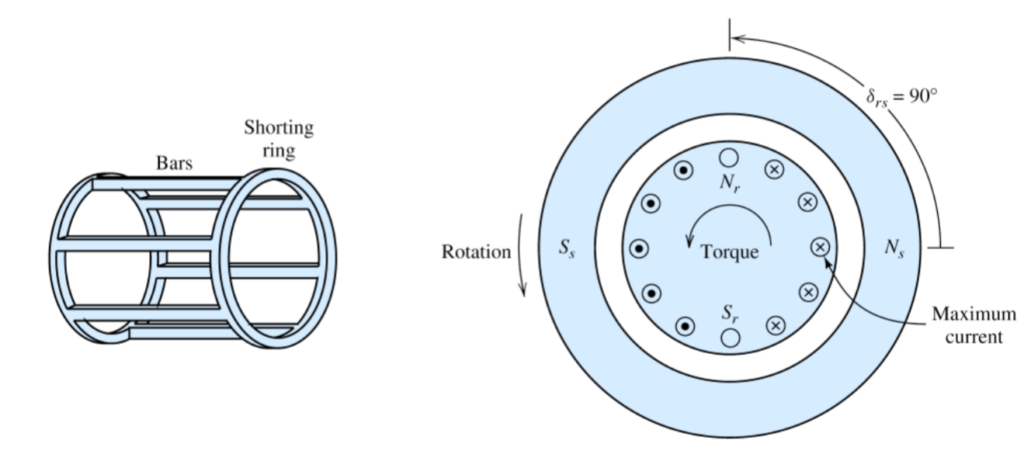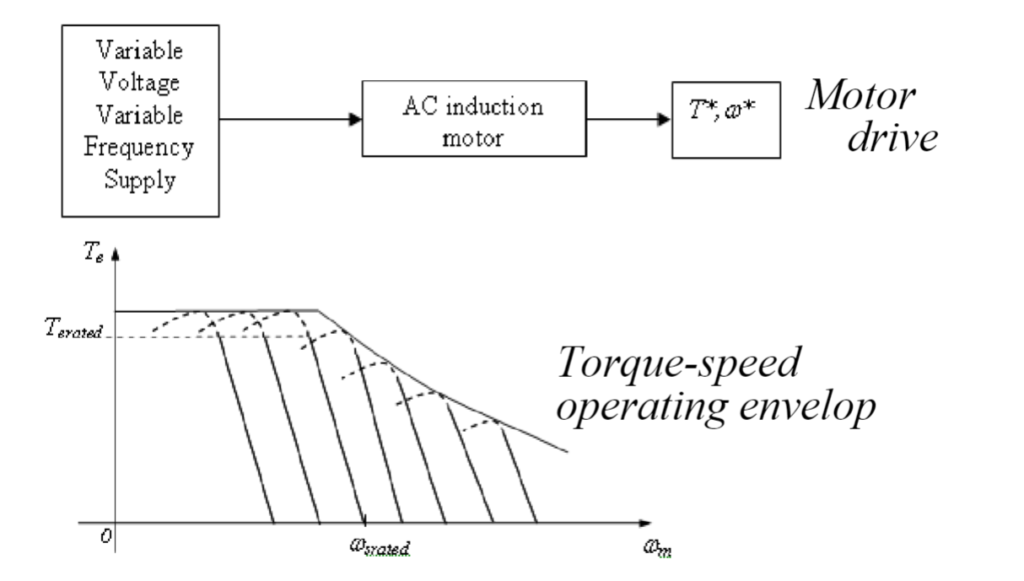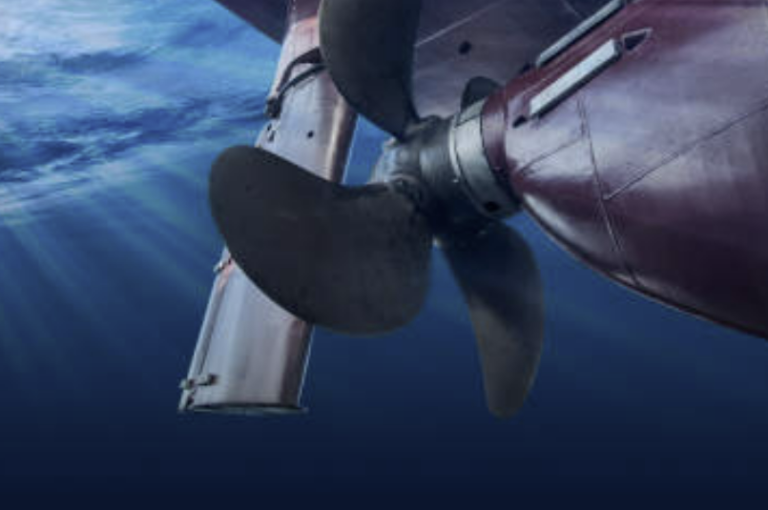The Power of a AC Motor
What are AC Motors? An AC motor or alternating current electric motor is powered by alternating current (AC) and typically comprises two main components. The outer stator contains coils that receive AC to create a rotating magnetic field, while the inner rotor, connected to the output shaft, generates another rotating magnetic field. The rotor’s magnetic field can be generated by permanent magnets, reluctance saliency, or DC or AC electrical windings. AC linear motors, though less common, operate similarly to rotating motors but have their stationary and moving parts aligned linearly, producing linear motion instead of rotational.

AC Motor Unveiled: The Basics
Let’s dive into the basics. AC stands for “alternating current,” which is the kind of electricity that switches direction cyclically. Now, picture this: you’ve got a coil of wire and a magnetic field. When you expose the coil to alternating current, a magnetic field is generated, which causes the coil to spin. In an AC motor, the armature is stationary as opposed to a DC motor. As a result, there is no commutator or brushes and the rotor circuit generates excitation. There are two main types of AC motors, induction or synchronous machines.
When was the AC motor invented?
Alternating current technology originated from the 1830–1831 discovery by Michael Faraday and Joseph Henry that a changing magnetic field can induce an electric current. Faraday is typically credited due to his earlier publication. In 1832, Hippolyte Pixii created a basic form of AC with the first alternator. Elihu Thomson expanded on this in 1886 with an AC motor, and in 1887, Charles Schenk Bradley patented a two-phase AC power transmission. Independently, Galileo Ferraris and Nikola Tesla invented “Commutatorless” AC induction motors, with Ferraris demonstrating a single-phase motor in 1885, and Tesla showcasing a two-phase model in 1887.
The Workhorses of AC Motor: Induction Motors:
Induction motors are like the workhorses of AC propulsion systems. Induction motors are electric motors that operate on a simple yet ingenious principle: electromagnetic induction. By using alternating current, propelled by a magnetic field that rotates.

As the stator’s magnetic field changes direction, it induces a current in the rotor, creating a magnetic field of its own. These two fields interact, generating the rotational force that sets the motor in motion.
Flavors of Induction Motors: More Than Just Vanilla
Just as there are different flavors of ice cream, there are different types of induction motors. There are single-phase induction motors, which kick-start when you flip a switch, and three-phase induction motors, which are the real powerhouses of industrial applications.
How does a 3-phase AC motor work?
A three-phase AC motor generates a rotating magnetic field in its stator windings using alternating current. This changing field induces currents in the rotor, resulting in an interaction between stator and rotor fields that creates rotational force for the motor’s movement. In operation, the stator and rotor together form the motor, where stator current induces a magnetic field causing rotor rotation.
• Three phase windings, in space at 120 degrees apart.
• Three-phase voltage (current) fed into the windings.

What are the main construction types of AC Motor construction?
There are two main types of AC motor construction:
- Stator construction
- Laminated iron core with slots
- Coils are placed in the slots to form a three or single-phase winding
- Squirrel-cage rotor construction
- Laminated Iron core with slots
- Metal bars are molded in the slots
- Two rings shortcircuit the bars
- The bars are slanted to reduce noise

Magnetic Fields and the Art of Whirling
Ever wondered how the magic of magnetic fields is conjured in these motors? It’s like a choreographed ballet between the stator and rotor. The stator’s windings are designed to create a magnetic field when AC flows through them. This field, in turn, induces currents in the rotor, leading to a counteracting magnetic field. This tug-of-war creates a force that spins the rotor – energy transfer at its finest!
What are the main types of AC motors?
There are several types of AC motors, each with its characteristics and applications:
Single Phase AC Motor:
Single-phase AC motors are utilized in locations with a single-phase power supply. These motors are smaller and more affordable, typically designed for fractional kilowatt capacities. Activated by a single-phase AC electrical supply, they differ from three-phase motors by having one main and one auxiliary winding, positioned perpendicular to each other. The rotor moves in response to the combined effect of two oppositely rotating fields, following the principle of the double-revolving field theory, resulting in equal and opposite torque.
Polyphase AC Motor:
Polyphase Motors, such as two or three-phase AC motors, differ from single-phase motors as their stator poles are not aligned, causing the rotor to pass by them at different times. These motors operate on a polyphase system, where equal voltages at the same frequency have a phase difference between adjacent electromagnetic fields. The most common polyphase system is three-phase, which produces 1.5 times more output than single-phase systems. Unlike the pulsating current of single-phase systems, the current from polyphase systems remains constant.
Synchronous Motors:
Synchronous motors operate at a constant speed that is synchronized with the frequency of the AC power supply. They have a higher efficiency than induction motors and are often used in applications where precise speed control is required, such as in industrial machinery and robotics.
Reluctance Motors:
Reluctance motors, as single-phase motors, achieve a precise rotating magnetic field without a synchronous speed. They utilize torque reluctance, a form of torque in iron devices, where the motor’s torque is produced by an exterior field inducing an inner field on the iron device. This torque is generated when the reluctance is oriented at angles to the poles of the outer field.
Hysteresis AC Motor:
The rotor of a hysteresis motor sets it apart from other AC motors, containing semi-permanent magnetic material. Torque is generated by the lag between magnetic flux and the external magnetizing force, with the current eddy producing the motor’s torque. Hysteresis motors offer precise speed control with minimal flutter and operate quietly. The rotor features a non-magnetic core with a special magnetic material layer, forming a smooth cylinder without windings, typically made of chrome or steel with a hysteresis loop.
Repulsion Motor:
A repulsion motor, a single-phase motor, operates by repelling similar poles. In addition to the rotor and stator, it includes a commutator brush assembly. The rotor features a distributed DC winding linked to the commutator, similar to a DC motor with short-circuited carbon brushes. The shortening of the rotor circuit allows it to receive power from the stator through transformer action. The motor functions by repelling similar poles, where the north poles and south poles repel each other.
Asynchronous Motor:
An asynchronous motor relies on induced current in its rotor to create rotational movement, making it the most common type of AC motor. The motor is powered by AC connected to the stator, with all power going to the stator and none to the rotor. The rotor’s induction occurs due to its proximity to the stator’s electromagnetic field, generating its field and causing rotation. Asynchronous motors, lacking brushes or slip rings, are highly efficient and reliable. They are favored for heavy-duty applications due to their simple, robust design.
Each type of AC motor has its advantages and disadvantages, making them suitable for different applications based on their specific requirements.
What are AC fields?
The generation of an AC magnetic field occurs when a coil carries alternating current. This current, frequently in the form of a sine wave, introduces time-based changes to the magnetic field. The equations below are for a 3-phase AC machine.

What does the air gap do in an AC motor?
To delve deeper, analogous definitions can be applied to AC electrical machines and DC machines. As per The Electro-mechanical Authority (EASA), within AC machines, the air gap denotes the space between the rotor cores and the stator. This gap is a key component in the motor design and affects the overall strength of the magnetic circuit and motor efficiency.

Synchronous Speed and Slip: The Dance of Rotation
Synchronous speed – the theoretical speed of rotation – is determined by the frequency of the AC power supply and the number of poles in the motor. But in the real world, perfection is a myth. Enter “slip,” the difference between synchronous speed and the actual speed of the rotor. This slip is essential; it’s what generates the force that pushes the motor to do its job.

Synchronous Speed vs. Number of Poles
The synchronous speed of an AC motor is influenced by the source frequency and the pole count. To compute RPM, multiply the frequency by 60 and then divide by the pole pairs. The formula is Ns (rpm) = (60 x f) / P, where f signifies frequency and P stands for the number of pole pairs.

What is the relation between slip and frequency?
As the rotor accelerates, the relative velocity between the rotor and the rotating magnetic field diminishes. Consequently, the slip (s) and consequently the rotor current frequency decrease. Calculating slip frequency involves gauging the phase angle covered within a set interval. If the phase angle measurement is available, determining slip becomes straightforward by arranging for the output to drive an accurately calibrated timer.

What are the forces acting on an electric AC motor?
Electric motors experience multiple forces during operation. The electromagnetic force, generated by the interaction between stator and rotor fields, initiates motion. Friction opposes motion, while load torque resists the motor’s rotational force. These combined influences determine the motor’s performance and efficiency.
The rotating field induces a current in the rotor bar. The current and field interaction generates the driving force. The force drives the motor, and the equation for the force = BLIr, where L is the length of the rotor.

Speed-Torque Characteristics: A Motor’s Personality
Think of speed-torque characteristics as a motor’s unique personality traits. How much torque can it provide as it starts from rest? How does its torque change as it speeds up? The answers lie in the speed-torque curve, which reveals the motor’s performance capabilities and helps engineers choose the right motor for a specific task. The motor is usually operated at low slip to have a more linear characteristic and maximize efficiency.

Speed Control Methods of an Induction Motor
Two main Methods:
• Stator terminal voltage control
• Stator frequency control
A power electronics converter is usually required
What are the drawbacks of variable stator voltage control?
The two drawbacks of a variable stator voltage control system are:
- Harmonics: – Excessive harmonics and back EMF arise, particularly in Delta connections, causing elevated losses and leading to motor overheating.
- Torque: – The Stator Voltage Control Method yields considerably low starting torque.

Why should we maintain a V/F ratio constant in induction motors?
When referring to V/f control of an induction motor, we’re discussing altering the motor’s speed by adjusting frequency while upholding a consistent V/f ratio. This is crucial to preserve the motor’s air gap flux and thereby maintain a steady torque output.

What is the VVVF method of speed control?
VVVF stands for Variable Voltage Variable Frequency. This technique is widely employed to regulate Induction Motors’ speed. By maintaining a constant V/f ratio, the frequency at which motor core saturation occurs is prevented from altering. This ensures effective speed control in induction motors.

In Conclusion: AC Motors Unplugged
So, the next time you plug in your vacuum cleaner or marvel at the precision of industrial machinery, remember the unseen hero behind the scenes – the AC motor. Its ingenious ability to harness the power of alternating current and convert it into motion is a testament to human innovation and engineering prowess. From the humble induction motor to the captivating dance of magnetic fields, the world of AC motors is a captivating journey into the heart of electromagnetism.
Whether you’re an aspiring engineer or just a curious soul fascinated by the inner workings of technology, the realm of AC motors offers a glimpse into a world where science, art, and power collide. It’s the hidden force that keeps our world spinning, and now, armed with this newfound knowledge, you can appreciate the electrifying magic that propels our modern lives forward.





